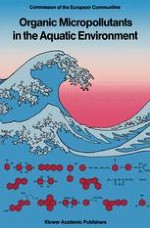1988 | OriginalPaper | Buchkapitel
Biodegradation of Chlorinated Aromatic Chemicals in Continuous Cultures
verfasst von : J. R. Parsons, D. T. H. M. Sijm, M. C. Storms
Erschienen in: Organic Micropollutants in the Aquatic Environment
Verlag: Springer Netherlands
Enthalten in: Professional Book Archive
Aktivieren Sie unsere intelligente Suche, um passende Fachinhalte oder Patente zu finden.
Wählen Sie Textabschnitte aus um mit Künstlicher Intelligenz passenden Patente zu finden. powered by
Markieren Sie Textabschnitte, um KI-gestützt weitere passende Inhalte zu finden. powered by
Chemostat (continuous) cultures of microorganisms offer a number of advantages for the study of the biodegradation of xenobiotic chemicals compared to the more commonly used batch systems. Chemostat cultures enable the influence of environmental conditions and adaptation on biodegradation to be studied, as well as simplifying kinetic studies.The cometabolic degradation of chlorobiphenyls by a Pseudomonas strain in batch and chemostat cultures was compared. In batch cultures there was ready degradation of mono- and dichlorobiphenyls, but not of tetrachlorobiphenyls, In contrast, tetrachlorobiphenyls were degraded in chemostat cultures exposed continuously to the compounds by means of a generator column. Degradation was apparently enhanced by the more favourable conditions in chemostat cultures, and not by adaptation of the bacteria.First order biodegradation rate constants for the tetrachlorobiphenyls were calculated from the steady state concentrations in the cultures and the exposure concentrations. The rate constant for 2,2′,3,3′-tetrachlorobiphenyl was much higher than those for the 2,2′,5,5′- and 2,2′,6,6′- isomers, suggesting that steric hindrance of 2,3-dioxygenation controls their degradation rates.
